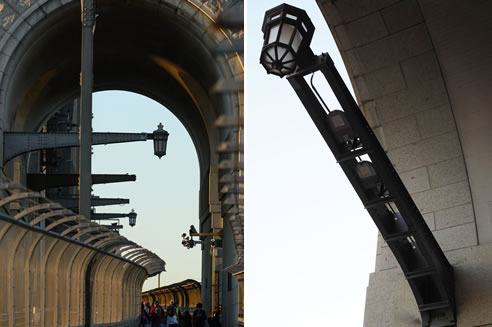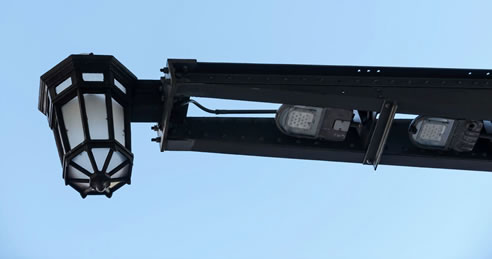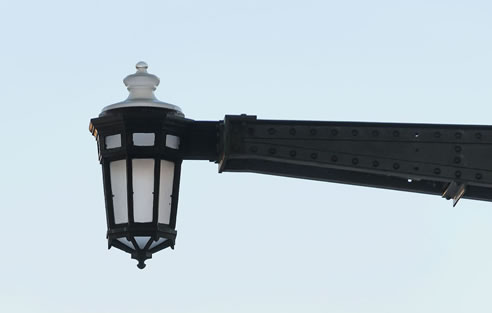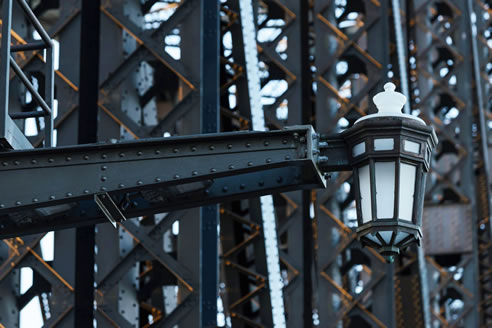Gerard Lighting Group has been operating in Australia for
over 100 years. Headquartered in Sydney, Gerard Lighting is
well known for providing its clients with sustainable and
innovative solutions for lighting, from industrial, commercial,
residential and infrastructure. With an extensive footprint
across Australia and New Zealand, Gerard Lighting has a
portfolio that incorporates the electrical industry's leading
brands. One of its most interesting projects has been its
work on recent changes to the lighting on the Sydney
Harbour Bridge.
The iconic Bridge was originally designed to create a sense of arrival or entry to a special place. When
completed in 1932, the Bridge's roadways were lined with distinctive bronze lantern fittings.
Unfortunately, the lights produced a glow that was deemed to be of detriment to drivers as traffic
volumes increased. The lanterns were removed in the 1950s and replaced with modern fittings for the
time. Without much foresight into their historical significance, most of the lanterns were also
unfortunately destroyed.
As the 21st century progresses, there has been an increased focus on preserving Australia's national
heritage and historical structures. Owned by the RMS (Road and Maritime Services), the Bridge's
heritage value is proudly being upheld with the RMS, ensuring that any changes or modifications
required to service contemporary requirements are done in a manner that are respectful to the original
architecture. In 2013, the decision was made to resurrect the original bronze lanterns in an effort to
provide both effective lighting, whilst also restoring the original aesthetic of the Bridge's unique
adornments.

First and foremost, Gerard Lighting's goal was to create a lighting solution
that was both functional and aesthetic while maintaining existing light
levels. The new lighting for the roadway, walkway and traffic had to be
unobtrusive and hidden from view, whilst the heritage lanterns needed to
produce a soft glow to recreate the heritage feel of the original bridge, all
without being a hindrance to traffic.
Fortuitously, the RMS were able to supply Gerard Lighting with a recast of
the original lantern which had resided in the Bridge museum. This was used
to create the moulds for the new lanterns at a foundry in Western Sydney.
Bronze was chosen as the preferred metal for its durability and because it
does not require painting. As with the original lanterns, parts were sourced
from local producers where possible.
Borosilicate was chosen as the glassware because of its high durability as well as its resistance to
expanding and contracting with temperature changes. The Heritage fitting is designed to glow, rather
than to contribute to the road lighting. The glass manufacturers asked Gerard Lighting to nominate the
type of glass and the amount of frosting that would be required to achieve the desired effect, and the
interior of the top dome is sand-blasted to produce this frosted diffusing light effect. Borosilicate flat
glass panels were held in place with highly durable compounds to allow the lanterns to remain water
tight. Gerard Lighting incorporated an additional visor over the module to counter any internal
condensation. They also recommended that the RMS include two bronze breathers to ensure pressure
equilibrium, which is very important to maintain a dry internal environment in the fitting.
Now for the lighting...
Gerard Lighting was given a carcass Heritage fitting that was used
to create a mock-up version, made of acrylic panels and an LED
module in order to determine the desired lighting effect. Gerard
Lighting then customised a double sided 15Watt LED fitting to be
seated inside each lantern, producing a soft glow that is rated as
maintenance free for 20 years - with over 100,000 hours at a very
low power consumption resulting in reduced energy and costs.

The modules are 3000k, chosen due to its ability to reproduce a warmer light that has a similar
ambience and effect to the original Heritage lantern. This warmth was chosen due to its urban design
with a heritage input, demonstrating a combination of modern technology with old world charm.
The LED lights were chosen in part because of how long they last, minimising the risk of smashing the
fragile glass top domes when changing lights. Two standard 37Watt Sylvania StreetLED streetlights
provide roadway illumination in order to address the original issue of in-effective illumination. These are
concealed within the light arm structures to reduce glare, whilst delivering drivers with a necessarily
compliant level of illumination to ensure road safety. The reduced glare allows the general public to
simply focus on the Heritage fitting while furthering the photogenic quality of the bridge. The new
lanterns will hang off 140 original outreaches, all located in the exact place as they were when the
Bridge was constructed.
The Bridge is always a work in progress requiring constant maintenance and enhancement. The array of
experts, in technical, design and engineering who contributed to the project was considerable. Upon
completion of the Heritage fitting, each unit weighed 120kg, resulting in structural engineers having to
sign off on each outreach. These outreaches had to be checked for rot and decay before the new
installations could begin and installation is restricted to times of road closures, which are very limited.
Once completed, this restoration project will result in substantial dollar in energy costs alone as well as
ensuring that the RMS can reduce maintenance and servicing costs. In addition, Gerard Lighting has
produced a lighting solution that meets today's lighting standards while also restoring a heritage look
and feel to the bridge. The new lighting solution provide all users of the bridge with safe and efficient
lighting, while preserving all the ambience of yesteryear.
For further information visit www.gerardlighting.com.au










 Frisbee Head LED Bollards by Pierlite
Frisbee Head LED Bollards by Pierlite Low Glare Suspended Light for Offices by
Low Glare Suspended Light for Offices by Compact LED Floodlight by Pierlite
Compact LED Floodlight by Pierlite Warehouse Lighting by Pierlite
Warehouse Lighting by Pierlite Smart Scan Sensor for Lights by Pierlite
Smart Scan Sensor for Lights by Pierlite LED Lighting Replacement for Carpark by
LED Lighting Replacement for Carpark by Lighting with IoT Sensors from Pierlite
Lighting with IoT Sensors from Pierlite Slimline LED Floodlights - Crompton
Slimline LED Floodlights - Crompton Cloud-Based Sports Field Lighting
Cloud-Based Sports Field Lighting Touch-Screen Lighting Management for
Touch-Screen Lighting Management for New Lighting Innovation Centre Sydney
New Lighting Innovation Centre Sydney Sustainable Lighting Company Gerard
Sustainable Lighting Company Gerard LED Luminaires With Integrated Sensors
LED Luminaires With Integrated Sensors Human-Centric LED Troffer Lighting from
Human-Centric LED Troffer Lighting from Smart Home Lighting Control from Gerard
Smart Home Lighting Control from Gerard Tunable White Luminaires - Siteco
Tunable White Luminaires - Siteco Three Colour Temperature Luminaires from
Three Colour Temperature Luminaires from Human Centric Lighting (HCL) with Gerard
Human Centric Lighting (HCL) with Gerard Sylvania Briteline Raptor LED Floodlight
Sylvania Briteline Raptor LED Floodlight Lighting Design and Control | Gerard
Lighting Design and Control | Gerard
